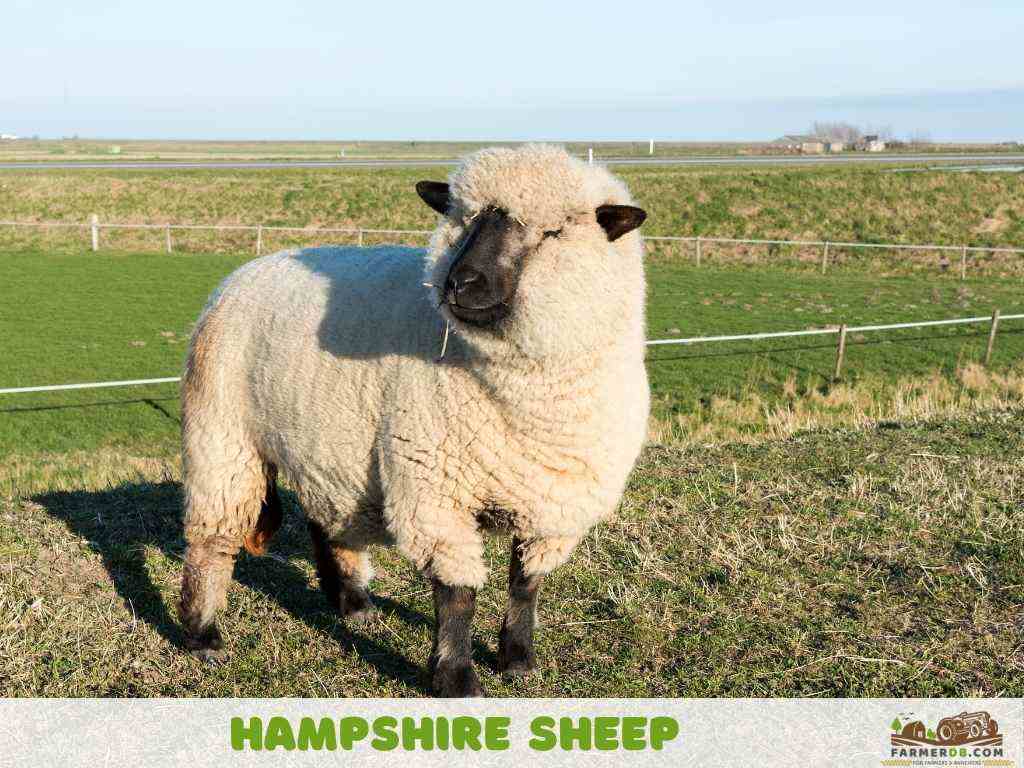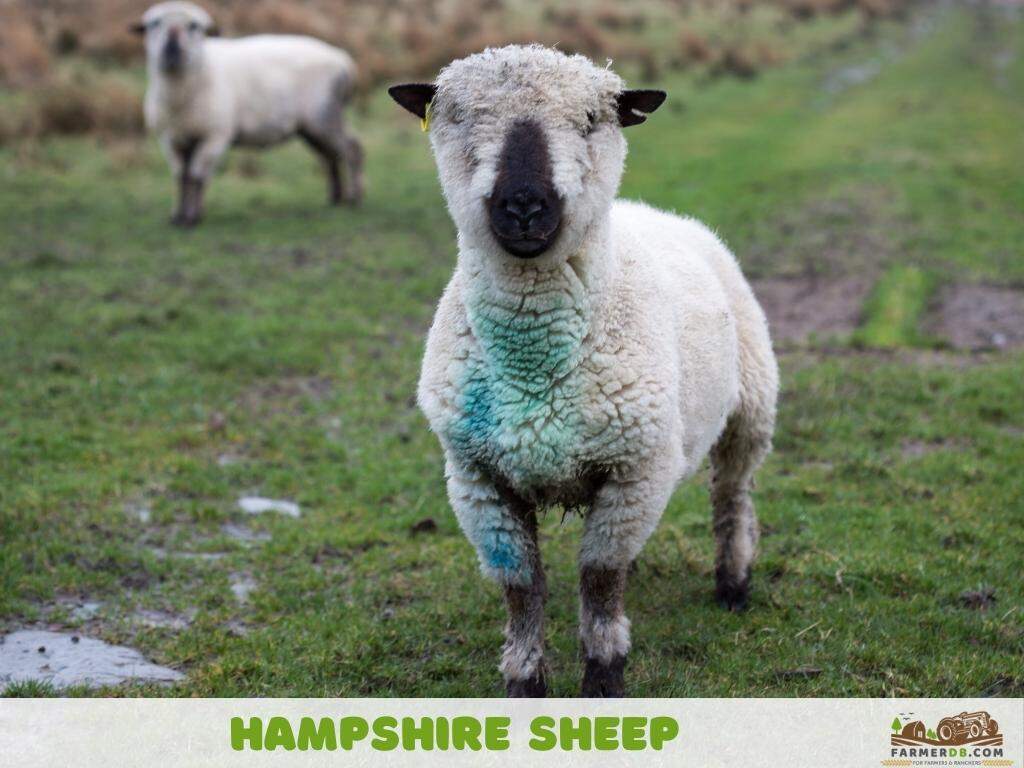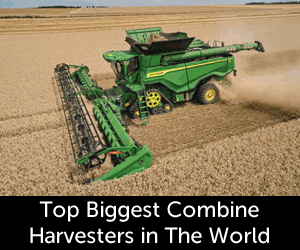Hampshire is a domestic, meat-focused sheep breed that originated in the early 19th century in the Hampshire Downs region of southern England.
The breed emerged through the crossing of Southdowns with Wiltshire Horn and Berkshire Knots. It was officially recognized in 1861, and the Hampshire Down Sheep Breeders’ Association was established in 1889 to support and promote it.
Over time, Hampshire sheep gained popularity, becoming a favored breed for meat production.
Today, they are widely raised in countries such as the United Kingdom, the United States, and Australia, remaining a significant and valued breed in modern agriculture.

Contents
Characteristics
Color
These sheep have a white or light cream fleece, while their face, ears, and legs are darker, either black or dark brown.
There should be no white spots on the jaws, legs, or ears.
Skin
The skin is free of wrinkles, and a healthy animal is preferred to have pink skin.
Head
The head is of good length and covered with short, coarse hair. It has an unbroken wool cap that extends from the neck over the forehead, while the area from the eyes downward is free of wool.
In rams, the head is broad and masculine, while in ewes, it is finer and more feminine in appearance.

Horns
This sheep breed is polled.
Horn buds, scurs, or snigs must not be present on the sheep.
Face
The face is dark in color, broad, and of good length. Below the eyes, it is free of wool and has short, coarse hair.
The nose is also broad, featuring dark brown or black coarse hair, with an open area around the eyes and a small amount of “frostiness” being acceptable.
Ears
The ears are moderate in length, thick, and covered with coarse dark brown or black hair, with no wool.
Teeth
The teeth meet the dental pad correctly, ensuring a proper bite without being positioned too far forward or backward.
Neck, Shoulders
The neck has strong, muscular growth, is of moderate length, and is free from excessive loose skin or a U-shape.
The shoulder blades sit squarely on either side of the spine, with no trough or ridge between them. They are broad and flat at the top without appearing coarse or heavy.
Body
- Chest and Brisket: These areas are wide and smooth, reflecting good body capacity.
- Back: The back is strong, level, and well-muscled, with a uniform appearance.
- Ribs: The ribs are deep and have adequate spring.
- Loin: The loin is long, wide, and deep.
- Rump and Hip: These areas are long, level, and wide at the pins.
- Hindquarters: The hindquarters show depth and significant muscle development.
- Underline: The underline is straight, indicating body depth and capacity.
Legs
The front and rear legs of the Hampshire sheep are well-positioned under the body, providing proper height and balance with the body size.
Strong bone structure is visible below the knees, and the hocks have a good angle for smooth and free movement.
The pasterns are strong, with toes close together, even in size, and a deep heel.
Reproductive Traits
Both rams and ewes have normal, well-developed reproductive organs.
Rams have a scrotal circumference of at least 13 inches (33 cm) by 12 months of age, supporting fertility and early maturity in their offspring.
Tail
The tail head is positioned high on the rump, not lower. In rams, the tail covers the anus, while in ewes, it covers the vulva.
Fleece
The fleece is of good length, uniform, and medium grade.
Size
Hampshire sheep are large in size.
Mature males have an average wither height of 31.5 inches (80 cm), while females average 27.6 inches (70 cm).
Lifespan
These sheep live around 10 to 12 years, which is average to slightly above average in the sheep world.
Their productive lifespan, particularly for breeding, is often shorter, ranging from 6 to 8 years.
Growth Rate
How fast do they grow?
This breed has a rapid growth rate, making it highly valued in meat production.
Under proper management and feeding, lambs can gain about 0.66 to 0.88 lbs (0.3 to 0.4 kg) per day.
Weight
Mature Hampshire males weigh 243 to 265 lbs (110 to 120 kg), while females weigh 176 to 200 lbs (80 to 91 kg). At birth, lambs usually weigh around 7.7 to 9.9 lbs (3.5 to 4.5 kg).
| Age (days) | Weight (lbs) (kg) |
|---|---|
| 1 | 7.7 to 9.9 (3.5 to 4.5 kg) |
| 11 | 15.9 to 17.9 (6.7 to 8.7 kg) |
| 31 | 32.1 to 34.1 (14.0 to 16.0 kg) |
| 41 | 39.4 to 41.4 (17.3 to 19.3 kg) |
| 81 | 65.7 to 67.7 (30.0 to 32.0 kg) |
| 91 | 71.9 to 73.9 (33.0 to 35.0 kg) |
| 101 | 77.9 to 79.9 (35.4 to 37.4 kg) |
| 111 | 83.7 to 85.7 (38.0 to 40.0 kg) |
| 121 | 89.4 to 91.4 (40.5 to 42.5 kg) |
| 161 | 110.8 to 112.8 (50.5 to 52.5 kg) |
| 171 | 115.9 to 117.9 (52.7 to 54.7 kg) |
| 201 | 130.7 to 132.7 (59.3 to 61.3 kg) |
| 211 | 135.5 to 137.5 (61.5 to 63.5 kg) |
Slaughtered Time
These sheep can be slaughtered at around 4 to 6 months of age, depending on the feeding regimen and growth rate.
Some farmers choose to wait longer to produce more meat but prefer to slaughter by 10 months of age to maintain the desired meat quality.
At around 4 to 6 months of age, they can reach a live weight of approximately 84 to 92 lbs (38–42 kg), resulting in a carcass weight of 42 to 48 lbs (19–22 kg).
This indicates that the slaughter yield of this sheep breed is around 51–53%, with the meat content of the carcass being 85.4%.
Temperament
These sheep are recognized for their gentle and calm behavior.
Although they are big and lively, they remain quiet and easygoing, which is useful for both farming and exhibitions.
This sheep breed also has efficient grazing behavior, utilizing pastures effectively. This trait helps maintain pasture health and reduces the need for additional feed, making them a valuable asset in sustainable farming practices.
Meat
The meat is valued for its tender texture and deep flavor, earning it recognition as a good choice for butchers and fine dining establishments.
The higher fat content enhances its succulence, while the marbling adds a delicate, slightly sweet flavor.
It is versatile, with a mild yet distinct taste that appeals to those who enjoy lamb as well as those who prefer a more delicate flavor. The natural richness of the meat is never overwhelming or “gamey,” making it suitable for a wide range of dishes.
Cuts with more fat, such as the shoulder, offer a fuller and richer flavor, while leaner cuts like the leg and loin are perfect for roasting or grilling due to their tender and juicy texture.
Some of the popular cuts are:
- Leg: One of the most popular cuts, the leg is tender and perfect for roasting. It weighs around 2.5 to 4.5 kg (5.5 to 10 lbs) depending on the size of the lamb.
- Loin chops: Known for their tenderness and juicy texture, loin chops are a premium cut often used for grilling or pan-searing. They are smaller but packed with flavor.
- Rack: A luxurious cut that includes the rib section, typically weighing 1 to 1.5 kg (2 to 3 lbs).
Wool
These sheep are not bred specifically for wool, but their dense fleece dyes well and is ideal for sturdy goods.
With a strong and elastic texture (24–33 microns), it resists felting and may even be machine washable. Ewes produce fleece weighing 6.6–8.2 lbs (3.0–3.7 kg), while rams yield 8.8–9.9 lbs (4.0–4.5 kg).
The fleece features a micron measurement of 25–33, a spinning count of 46–58, a staple length of 2–3.5 inches (5–9 cm), and a yield of 50–62 percent.
Raising
Feeding
Hampshire sheep eat mostly grass, which is their main source of food.
They are good at grazing and can eat different types of pasture, like clover and other forage plants. They can also eat hay, silage, and other stored forage, especially in winter or when there is not enough fresh grass.
Grains such as barley, oats, and corn can be added to their diet to help them grow.
Pregnant and lactating ewes need extra grains to give them the energy and nutrients they require during this important time.
Protein-rich feeds such as soybean meal or alfalfa pellets support their health and strength. Providing minerals and salt licks ensures they receive the nutrients they need to stay in good condition.
In some cases, Hampshire sheep can eat plants like turnips or kale, as well as root vegetables like sugar beets or carrots. Just be careful to limit the amount of kale fed to sheep.
Shearing
Hampshire sheep need shearing because their wool grows all year.
This is usually done once a year in late spring or early summer to keep them cool during the warmer months and to prevent problems like flystrike.
Environment
These sheep are well-suited for both extensive and intensive farming systems due to their adaptability and efficient growth.
They perform well in pasture-based systems, effectively using available grass and forage. Also, this breed is also highly regarded in intensive setups focused on achieving rapid growth and producing high-quality meat.
Climate
They are a hardy breed that can withstand a variety of climates:
- Temperate climates: They grow well in moderate climates with mild summers and winters, which are ideal for grazing on natural pastures.
- Cold climates: Thanks to their thick wool and robust build, Hampshire sheep can tolerate cold temperatures and are often raised in regions with harsh winters, as long as shelter and proper feeding are provided.
- Warm climates: While they prefer cooler environments, these sheep can also adapt to warmer climates when shade and adequate water are available to prevent heat stress.
- Wet climates: With proper attention, this breed is capable of handling wet climates effectively.
Shelter
Providing shelter is essential for Hampshire sheep to protect them from difficult weather conditions and keep them healthy.
For mild climates with balanced summers and winters, a simple structure is enough. A roof and open sides help keep the sheep dry and cool during warmer periods.
In colder climates, they need a well-insulated shelter to shield them from snow, frost, and freezing winds. The shelter should have solid walls, proper bedding such as straw, and adequate ventilation to prevent dampness while retaining warmth.
In hot climates, sheep require shaded areas to prevent heat stress and dehydration. A shelter with a high roof, open sides, and good airflow is ideal to keep them cool. Alternatively, shade from trees can also provide effective relief from direct sunlight, especially in grazing areas.
In regions with high rainfall or wet conditions, a sturdy and dry shelter is essential to prevent fleece damage and health issues such as foot rot. The shelter should have raised flooring, sloped roofs to drain rainwater, and enough space for all sheep to stay dry during heavy rains.
How many sheep per acre?
Good-quality pastures with plenty of grass and proper care can sustain about 5 sheep per acre. For average-quality land, the stocking rate drops to 2-3 sheep per acre.
Rotational grazing practices can improve pasture efficiency, enabling farmers to raise more sheep per acre without the risk of overgrazing.
Breeding
The Hampshire sheep breed is known for its early maturity and good fertility.
The breeding process is most commonly done through natural mating, where rams are introduced to ewes during their estrus cycle to ensure successful reproduction.
The ewes start going into heat in early January and will cycle every 16 days until May if they are not bred. The most active breeding period happens in March and April, which often results in more multiple births. Some ewes have less strict breeding seasons and can start cycling as early as late October.
Ewes born in the spring usually begin cycling at 9 to 12 months of age, while ram lambs become fertile between 7 and 9 months and can breed with 15 to 25 ewes. Yearling and older rams can mate with 30 to 60 ewes in one season.
Before breeding, ensure that ewes weigh at least 70% of their mature body weight. This helps them handle pregnancy and lambing safely, reducing the risk of complications.
As a tip to manage and monitor breeding in larger flocks, rams can be fitted with a marking harness containing oil-based dye applied to their chest or sheath. This dye leaves a mark on the rump of ewes during mating, making it easier for farmers to track which ewes have been bred. It also helps predict lambing dates (146–147 days after breeding) and identify issues such as infertility or embryo loss (25–40 days after breeding).
Hampshire ewes are very good mothers with strong maternal instincts, typically managing lambing with minimal assistance.
Farmers should still monitor lambing closely to address any potential issues, especially in first-time mothers or during challenging weather conditions.
Their lambs are lively and quick to stand shortly after birth, which helps improve survival rates. The ewes produce enough milk to support their lambs, even in the case of twins or triplets.
Their combination of good milk production and natural mothering abilities ensures that lambs receive proper nutrition and care during their early development.

Health Issues
This sheep breed can be affected by certain health issues. Two notable health concerns for Hampshire sheep are scrapie (see refs.) and spider lamb syndrome (SLS)(see refs.)
, but they can also be affected by common sheep illnesses if not cared for properly.
Regular health management, proper nutrition, and preventative measures are essential to keeping them healthy and minimizing the risk of these and other conditions.
Scrapie and spider lamb syndrome (SLS) can only be identified through genetic testing, which is highly recommended by breeders and sheep associations. Regular testing helps ensure healthier breeding practices by identifying carriers and preventing the spread of these conditions within flocks.
Why should you raise it?
For homesteaders, Hampshire sheep offer a perfect balance of practicality and versatility.
They grow quickly, providing high-quality, flavorful meat that’s perfect for family use or local sales. Their calm and friendly temperament makes them easy to manage, even for beginners, and ideal for families with children.
These sheep are great for programs like 4-H or FFA, giving kids the opportunity to learn about animal care, responsibility, and farming firsthand.
For smaller farms with diverse livestock looking to add sheep, Hampshire sheep bring unique benefits that set them apart.
They are adaptable and fit seamlessly into rotational grazing systems, making them easy to integrate alongside other animals without overburdening pasture.
Their friendly temperament and ease of handling make them manageable even in mixed-species setups, reducing stress on both the farmer and the flock.
Financially, these sheep can be a profitable option. They reach market weight in 4 to 6 months, and their ability to produce multiple lambs, coupled with minimal lambing issues, increases productivity.
Advantages
- Rapid growth rate
- High-quality meat
- Adaptability and versatility to different farming systems
- Efficient grazers
- Calm temperament
- Early maturity and good fertility
- Strong maternal instinct
Disadvantages
- Genetic concerns: Breeding requires careful genetic testing to avoid issues like SLS and scrapie in the flock.
- Seasonal Breeding: Being seasonal breeders can limit lambing times unless carefully planned.
References
- Hampshire Down Sheep Breeders’ Association link
- American Hampshire Sheep Association link
- Scrapie in sheep link
- Spider Syndrome in the Sheep Flock link
Do you have any experience with the topic discussed here?
Would you like to improve the information shared and contribute your practical knowledge on the subject?
Your real-world experience as a farmer or rancher could greatly benefit other members, and the community would deeply appreciate your contribution.

